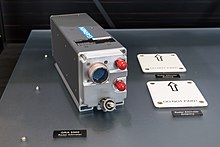Radar altimeter
With radar altimeter or radio altimeter an on-board-based is radar indicated that the exact altitude of a satellite or an aircraft in accordance with the radar method measures. It is part of the navigation equipment of larger aircraft , measures the altitude above ground using short electromagnetic waves and supplements the usual barometric altimeters . Radar altimeters work very precisely, especially at low altitudes and, in contrast to barometric altimeters, do not measure the height above sea level ( QNH ), but the real height above ground.
Radar altimeter with FMCW method
Radar altimeters mostly use the FMCW principle for low altitudes . Since these devices are usually permanently connected to the aircraft, a measurement error would occur if the transmission energy were sharply bundled in a fixed direction due to the aircraft rolling and nodding . For this reason, antennas with a relatively low directional effect are used, which radiate safely towards the ground regardless of the flight position. In radar signal processing, only the smallest measured difference frequency is used here for the height calculation. This always points to the reflecting surface with the shortest distance to the aircraft.
In order to enable a relatively high transmission power, the transmission antenna and reception antenna are installed as far apart as possible in the wings. The fuselage forms an additional shield between the two antennas and thus prevents direct coupling from the transmitting antenna to the receiving antenna.
When flying low, a warning height can be continuously set on the radar altimeter in military aircraft ( terrain follower radar ). If the altitude falls below this level, the pilot is warned by a signal (optical or acoustic). During instrument approaches from military or civil aircraft, a minimum is also set at which the radar altimeter gives an alarm. If the pilot does not have the runway in sight, he has to take off. The radar altimeter is a requirement for a CAT II or CAT III approach (see also: Instrument landing system ); the terrain for such an approach is mapped (Precision Approach Terrain Chart; PATC) so that the display can be interpreted correctly.
Radar altimeter in pulse mode
If a radar altimeter is used by an aircraft at high altitude or by a satellite, the FMCW method is not used, but the pulse radar method . Due to the special feature that no single point is illuminated, but an area, the echo signal is deformed during the reflection. Given the great height of the satellites, this deformation can be so significant that special radar signal processing is required. The illuminated area increases gradually until the transmission pulse has already ended in the middle of the illuminated area, while the reflection of the transmission pulse only begins at the edge of the illuminated area.
The formerly steep edge of the transmission pulse can no longer be recognized in the echo signal. The previously short transmit pulse is lost in the rising edge of the echo signal. The pulse duration of the echo signal can increase to a multiple of the duration of the transmission pulse. The point at which the rising edge of the echo signal merges into the impulse roof is used as the measuring point for the timing of the transit time measurement. This is a big problem, especially when using intrapulse modulation , since different sections of the modulation overlap with one another, shifted in time. A phase modulation is therefore not appropriate for radar altimeters, since the phase coding is lost at the latest in the pulse roof of the echo signal due to interference.



